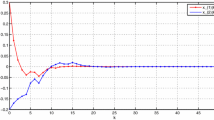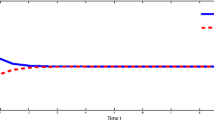Appendix I
Proof of Theorem 1
Proof
By Lemma 3, we know that inequality (4) holds if and only if the following is true:
$$ {\Omega}+(\tau-\bar{\tau})RZ_{1}^{-1}R^{T}+(\tau-\bar{\tau})SZ_{1}^{-1}S^{T}+\bar{\tau}WZ_{1}^{-1}W^{T}<0 $$
(8)
where
$$\begin{array}{@{}rcl@{}} R\!&=&\!\left[\!\begin{array}{c} {R_{1}^{T}}\quad\! {R_{2}^{T}}\quad\! {R_{3}^{T}}\quad\! {R_{4}^{T}}\quad\! {R_{5}^{T}}\quad\! {R_{6}^{T}}\quad\! {R_{7}^{T}}\quad\! {R_{8}^{T}}\quad\! {R_{9}^{T}} \quad\! 0\quad\! 0 \end{array}\!\right]^{T},\\ S\!&=&\!\left[\!\begin{array}{c} {S_{1}^{T}}\quad\! {S_{2}^{T}}\quad\! {S_{3}^{T}}\quad\! {S_{4}^{T}}\quad\! {S_{5}^{T}}\quad\! {S_{6}^{T}}\quad\! {S_{7}^{T}}\quad\! {S_{8}^{T}}\quad\! {S_{9}^{T}}\quad\! 0\quad 0\! \end{array}\!\right]^{T},\\ W\!&=&\!\left[\!\begin{array}{c} {W_{1}^{T}}\quad\! {W_{2}^{T}}\quad\! {W_{3}^{T}}\quad\! {W_{4}^{T}}\quad\! {W_{5}^{T}}\quad\! {W_{6}^{T}} \quad\! {W_{7}^{T}}\quad\! {W_{8}^{T}}\quad\! {W_{9}^{T}}\quad\! 0\! \quad 0 \end{array}\!\right]^{T}, \end{array} $$
$${\Omega}\,=\,\left[\! \begin{array}{ccccccccccc} {\Pi}_{11} & {\Pi}_{12} & {\Pi}_{13} & {\Pi}_{14} & {\Pi}_{15} & {\Pi}_{16} & {\Pi}_{17} & {\Pi}_{18} & {\Pi}_{19}& S_{1}-W_{1} & -R_{1} \\ \ast & {\Pi}_{22} & {\Pi}_{23} & {\Pi}_{24} & {\Pi}_{25} & {\Pi}_{26} & 0 & 0 & {\Pi}_{29}&S_{2}-W_{2} & -R_{2} \\ \ast & \ast & {\Pi}_{33} & {\Pi}_{34} & {\Pi}_{35} & {\Pi}_{36} & 0 & 0 & {\Pi}_{39}&S_{3}-W_{3} & -R_{3} \\ \ast & \ast & \ast & {\Pi}_{44} & {\Pi}_{45} & {\Pi}_{46} & 0 & 0& {\Pi}_{49}&S_{4}-W_{4} & -R_{4} \\ \ast & \ast & \ast & \ast & {\Pi}_{55} & {\Pi}_{56} & 0 & 0& {\Pi}_{59} &S_{5}-W_{5} & -R_{5} \\ \ast & \ast & \ast & \ast & \ast & {\Pi}_{66} & 0 & 0& {\Pi}_{69}& S_{6}-W_{6} & -R_{6}\\ \ast & \ast & \ast & \ast & \ast & \ast & {\Pi}_{77} & 0& {\Pi}_{79}& S_{7}-W_{7} & -R_{7}\\ \ast & \ast & \ast & \ast & \ast & \ast & \ast & {\Pi}_{88}& {\Pi}_{89}&S_{8}-W_{8} & -R_{8}\\ \ast & \ast & \ast & \ast & \ast& \ast & \ast & \ast & {\Pi}_{99}&S_{9}-W_{9} & -R_{9} \\ \ast & \ast & \ast & \ast & \ast& \ast & \ast & \ast & \ast & -Q_{1} & 0 \\ \ast & \ast & \ast & \ast & \ast& \ast & \ast & \ast&\ast & \ast & -Q_{3} \\ \end{array} \!\right]\!. $$
Defining η(k) = x(k + 1) − x(k),we consider the Lyapunov-Krasovskii functional candidate for model (1) as follows
$$V(k,x(k))=\sum\limits^{7}_{i=1}V_{i}(k,x(k)), $$
where
$$\begin{array}{@{}rcl@{}} V_{1}(k,x(k))&=&x^{T}(k)Px(k),\\ V_{2}(k,x(k))&=&\sum\limits^{k-1}_{j=k-\bar{\tau}}x^{T}(j)Q_{1}x(j),\\ \end{array} $$
$$\begin{array}{@{}rcl@{}} V_{3}(k,x(k))&=&\sum\limits^{k-1}_{j=k-\tau(k)}x^{T}(j)Q_{2}x(j)\\ &&+\sum\limits^{k-\bar{\tau}}_{l=k-\tau+1}\sum\limits^{k-1}_{j=l}x^{T}(j)Q_{2}x(j),\\ V_{4}(k,x(k))&=&\sum\limits^{k-1}_{j=k-\tau}x^{T}(j)Q_{3}x(j),\\ V_{5}(k,x(k))&=&\sum\limits^{k-1}_{l=k-\tau}\sum\limits^{k-1}_{j=l}\eta^{T}(j)Z_{1}\eta(j),\\ V_{6}(k,x(k))&=&\sum\limits^{\infty}_{d=1}\mu_{d}\sum\limits^{k-1}_{j=k-d}f^{T}(x(j))Z_{2}f(x(j)),\\ V_{7}(k,x(k))&=&\sum\limits^{q}_{m=1}\sum\limits^{k-1}_{i=k-\tau_{m}(k)}h^{T}(x(i)){\Theta}_{m}h(x(i))\\ &&+\sum\limits^{q}_{m=1}\sum\limits^{-d_{min}}_{j=-d_{max}+1} \sum\limits^{k-1}_{i=k+j}h^{T}(x(i)){\Theta}_{m}h(x(i)). \end{array} $$
Calculating the difference of V (k)along the trajectories of model (1) and taking the mathematical expectation, we obtain
$$\mathbb{E}\left\{\Delta V(k,x(k))\right\}=\sum\limits^{7}_{i=1}\mathbb{E}\left\{\Delta V_{i}(k,x(k))\right\}, $$
where
$$\begin{array}{@{}rcl@{}} \mathbb{E}\left\{\Delta V_{1}(k,x(k))\right\}&\,=\,&\mathbb{E}\left\{\vphantom{PD \sum\limits^{\infty}_{d=1}}x^{T}(k)(A^{T}PA-P)x(k)\right.\\ &&+2x^{T}(k)A^{T}PBy(k)\\ &&+2\bar{\alpha} x^{T}(k)A^{T}PCy(k-\tau(k))\\ &&+2\bar{\beta}x^{T}(k)A^{T}PD \sum\limits^{\infty}_{d=1}\mu_{d}f(x(k-d))\\ &&+2\bar{\gamma} x^{T}(k)A^{T}PE\sum\limits^{q}_{m=1}h(x(k\,-\,\tau_{m}(k)))\\ &&\!+2x^{T}(k)A^{T}Pu(k)\,+\,y^{T}(k)B^{T}PBy(k)\\ &&+2\bar{\alpha} y^{T}(k)B^{T}PCy(k-\tau(k))\\ &&+2\bar{\beta}y^{T}(k)B^{T}PD\sum\limits^{\infty}_{d=1} \mu_{d}f(x(k\,-\,d))\\ &&+2\bar{\gamma} y^{T}(k)B^{T}PE\!\sum\limits^{q}_{m=1}\!h(x(k\,-\,\tau_{m}(k)))\\ &&+2y^{T}(k)B^{T}Pu(k)\\ &&+{\bar{\alpha}} y^{T}(k-\tau(k))C^{T}PCy(k-\tau(k))\\ &&+2\bar{\alpha}\bar{\beta}y^{T}(k-\tau(k))C^{T}PD \end{array} $$
$$\begin{array}{@{}rcl@{}} &&{\kern6.5pc}\times\sum\limits^{\infty}_{d=1} \mu_{d}f(x(k-d))\\ &&{\kern6.5pc}+2\bar{\alpha}\bar{\gamma} y^{T}(k-\tau(k))C^{T}PE\\ &&{\kern6.5pc}\times\sum\limits^{q}_{m=1}h(x(k-\tau_{m}(k)))\\ &&{\kern6.5pc}+2\bar{\alpha} y^{T}(k-\tau(k))C^{T}Pu(k)\\ &&{\kern6.5pc}+{\bar{\beta}}\sum\limits^{\infty}_{d=1} \mu_{d}f^{T}(x(k-d))D^{T}PD\\ &&{\kern6.5pc}\times\sum\limits^{\infty}_{d=1}\mu_{d}f(x(k-d))\\ &&{\kern6.5pc}+2\bar{\beta}\bar{\gamma}\sum\limits^{\infty}_{d=1}\mu_{d}f^{T}(x(k-d))D^{T}PE\\ &&{\kern6.5pc}\times\sum\limits^{q}_{m=1} h(x(k-\tau_{m}(k)))\\ &&{\kern6.5pc}+2\bar{\beta}\sum\limits^{\infty}_{d=1} \mu_{d}f^{T}(x(k-d))D^{T}Pu(k)\\ &&{\kern6.5pc}+{\bar{\gamma}}\sum\limits^{q}_{m=1} h^{T}(x(k-\tau_{m}(k)))E^{T}PE\\ &&{\kern6.5pc}\times\sum\limits^{q}_{m=1} h(x(k-\tau_{m}(k)))\\ &&{\kern6.5pc}+2\bar{\gamma}\sum\limits^{q}_{m=1} h^{T}(x(k-\tau_{m}(k)))E^{T}Pu(k)\\ &&{\kern6.5pc} +u^{T}(k)Pu(k)\\ &&{\kern6.5pc}\left.+\sigma^{T}(x(k),x(k-\tau(k)),k)P\sigma(x(k),\right.\!\\ &&{\kern6.5pc}\left.x(k-\tau(k)),k)\vphantom{PD \sum\limits^{\infty}_{d=1}}\right\}, \end{array} $$
(9)
$$\begin{array}{@{}rcl@{}} &&\mathbb{E}\left\{\Delta V_{2}(k,x(k))\right\}\\&&= \mathbb{E}\left\{x^{T}(k)Q_{1}x(k)-x^{T}(k-\bar{\tau})Q_{1}x(k-\bar{\tau})\right\}, \end{array} $$
(10)
$$\begin{array}{@{}rcl@{}} \mathbb{E}\left\{\Delta V_{3}(k,x(k))\right\}&=&\mathbb{E}\left\{\sum\limits^{k}_{j=k+1-\tau(k+1)}x^{T}(j)Q_{2}x(j)\right.\\ &&\qquad\left.+\sum\limits^{k+1-\bar{\tau}}_{l=k-\tau+2}\sum\limits^{k}_{j=l}x^{T}(j)Q_{2}x(j)\right.\\ &&\qquad-\sum\limits^{k-1}_{j=k-\tau(k)}x^{T}(j)Q_{2}x(j)\\ &&\qquad-\left.\sum\limits^{k-\bar{\tau}}_{l=k-\tau+1}\sum\limits^{k-1}_{j=l}x^{T}(j)Q_{2}x(j)\right\} \end{array} $$
$$\begin{array}{@{}rcl@{}} &&\qquad\qquad{}=\mathbb{E}\left\{\sum\limits^{k-\bar{\tau}}_{j=k+1-\tau(k+1)}x^{T}(j)Q_{2}x(j)\right.\\ &&\qquad\qquad+\sum\limits^{k-1}_{j=k+1-\bar{\tau}}x^{T}(j)Q_{2}x(j)\\ &&\qquad\qquad+ x^{T}(k)Q_{2}x(k)\\ &&\qquad\qquad-\sum\limits^{k-1}_{j=k+1-\tau(k)}x^{T}(j)Q_{2}x(j)\\ &&\qquad\qquad- x^{T}(k-\tau(k))Q_{2}x(k-\tau(k)) \\ &&\qquad\qquad+(\tau-\bar{\tau})x^{T}(k)Q_{2}x(k)\\ &&\qquad\qquad-\left.\sum\limits^{k-\bar{\tau}}_{l=k+1-\tau}x^{T}(l)Q_{2}x(l)\right\}\\ &&\qquad\qquad{}\leq\mathbb{E}\left\{(1+\tau-\bar{\tau})x^{T}(k)Q_{2}x(k)\right.\\ &&\qquad\qquad\left.-x^{T}(k-\tau(k))Q_{2}x(k-\tau(k))\right\}, \end{array} $$
(11)
$$\begin{array}{@{}rcl@{}} \mathbb{E}\left\{\Delta V_{4}(k,x(k))\right\}&=&\mathbb{E}\left\{x^{T}(k)Q_{3}x(k)\right.\\ &&-\left.x^{T}(k-\tau)Q_{3}x(k-\tau)\right\}, \end{array} $$
(12)
$$\begin{array}{@{}rcl@{}} \mathbb{E}\left\{\Delta V_{5}(k,x(k))\right\}&\,=\,&\mathbb{E}\left\{\!\tau\eta^{T}(k)Z_{1}\eta(k)\,-\,\sum\limits^{k-1}_{j=k-\tau}\eta^{T}(j)Z_{1}\eta(j)\!\right\}\\ &=&\mathbb{E}\left\{\vphantom{\left.\!-\sum\limits^{k-1}_{j=k-\bar{\tau}}\eta^{T}(j)Z_{1}\eta(j)\right\}}\tau x^{T}(k)((A-I)^{T}Z_{1}(A-I))x(k)\right.\\ &&+2\tau x^{T}(k)(A-I)^{T}Z_{1}By(k) \\ &&+2\tau\bar{\alpha} x^{T}(k)(A-I)^{T}Z_{1}Cy(k-\tau(k))\\&&+2\tau\bar{\beta} x^{T}(k)(A-I)^{T}Z_{1}D\\ &&\times\sum\limits^{\infty}_{d=1}\mu_{d}f(x(k-d))\\ &&+2\tau\bar{\gamma}x^{T}(k)(A-I)^{T}Z_{1}E\\ &&\times\sum\limits^{q}_{m=1}h(x(k-\tau_{m}(k)))\\ &&+2\tau x^{T}(k)(A-I)^{T}Z_{1}u(k)\\ &&+\tau y^{T}(k)B^{T}Z_{1}By(k)\\ &&+2\tau\bar{\alpha} y^{T}(k)B^{T}Z_{1}Cy(k-\tau(k))\\ &&+2\tau\bar{\beta}y^{T}(k)B^{T}Z_{1}D\sum\limits^{\infty}_{d=1}\mu_{d}f(x(k\,-\,d))\\ &&\,+\,2\tau\bar{\gamma} y^{T}(k)B^{T}Z_{1}E\sum\limits^{q}_{m=1}h(x(k\,-\,\tau_{m}(k)))\\ &&+2\tau y^{T}(k)B^{T}Z_{1}u(k)\\ &&+\tau\bar{\alpha} y^{T}(k-\tau(k))C^{T}Z_{1}Cy(k\,-\,\tau(k))\\ &&+2\tau\bar{\alpha}\bar{\beta}y^{T}(k-\tau(k))C^{T}Z_{1}D\\ &&\times\sum\limits^{\infty}_{d=1} \mu_{d}f(x(k-d)) \end{array} $$
$$\begin{array}{@{}rcl@{}} &&{\kern6.5pc}+2\tau\bar{\alpha}\bar{\gamma} y^{T}(k-\tau(k))C^{T}Z_{1}E\\ &&{\kern6.5pc}\times\sum\limits^{q}_{m=1}h(x(k-\tau_{m}(k)))\\ &&{\kern6.5pc}+2\tau\bar{\alpha}y^{T}(k-\tau(k))C^{T}Z_{1}u(k)\\ &&{\kern6.5pc}+\tau{\bar{\beta}}\sum\limits^{\infty}_{d=1}\mu_{d}f^{T}(x(k-d))D^{T}Z_{1}D\\ &&{\kern6.5pc}\times\sum\limits^{\infty}_{d=1}\mu_{d}f(x(k-d))\\ &&{\kern6.5pc}+2\tau\bar{\beta}\bar{\gamma}\sum\limits^{\infty}_{d=1}\mu_{d}f^{T}(x(k-d))D^{T}Z_{1}E\\ &&{\kern6.5pc}\times\sum\limits^{q}_{m=1} h(x(k-\tau_{m}(k)))\\ &&{\kern6.5pc}+2\tau\bar{\beta} \sum\limits^{\infty}_{d=1} \mu_{d}f^{T}(x(k\,-\,d))D^{T}Z_{1}u(k)\\ &&{\kern6.5pc} \!+\tau{\bar{\gamma}}\sum\limits^{q}_{m=1} h^{T}(x(k-\tau_{m}(k)))E^{T}Z_{1}E\\ &&{\kern6.5pc}\times\sum\limits^{q}_{m=1} h(x(k-\tau_{m}(k)))\\ &&{\kern6.5pc}\!+2\tau\bar{\gamma}\sum\limits^{q}_{m=1}\! h^{T}(x(k\,-\,\tau_{m}(k)))E^{T}Z_{1}u(k)\\ &&{\kern6.5pc}+\tau u^{T}(k)Z_{1}u(k)\\ &&{\kern6.5pc}\!+\tau\sigma^{T}(x(k),x(k\,-\,\tau(k)),k)Z_{1}\sigma(x(k),\!\\ &&{\kern6.5pc}x(k-\tau(k)),k)\\ &&{\kern6.5pc}\!-\sum\limits^{k-1-\tau(k)}_{j=k-\tau}\eta^{T}(j)Z_{1}\eta(j)\\ &&{\kern6.5pc}\!-\sum\limits^{k-1-\bar{\tau}}_{j=k-\tau(k)}\eta^{T}(j)Z_{1}\eta(j)\\ &&{\kern6.5pc}\left.\!-\sum\limits^{k-1}_{j=k-\bar{\tau}}\eta^{T}(j)Z_{1}\eta(j)\right\}, \end{array} $$
(13)
$$\begin{array}{@{}rcl@{}} \mathbb{E}\left\{\Delta V_{6}(k,x(k))\right\}&\,=\,&\mathbb{E}\left\{\sum\limits^{\infty}_{d=1}\mu_{d}\sum\limits^{k}_{j=k+1-d}f^{T}(x(j))Z_{2}f(x(j))\right.\\ &&\!\left.-\sum\limits^{\infty}_{d=1}\mu_{d}\sum\limits^{k-1}_{j=k-d}f^{T}(x(j))Z_{2}f(x(j))\right\}\\ &\,=\,&\mathbb{E}\left\{\sum\limits^{\infty}_{d=1}\mu_{d}f^{T}(x(k))Z_{2}f(x(k))\right.\\ &&\!\left.-\sum\limits^{\infty}_{d=1}\mu_{d}f^{T}(x(k-d))Z_{2}f(x(k-d))\right\}, \end{array} $$
(14)
$$\begin{array}{@{}rcl@{}} \mathbb{E}\left\{\Delta V_{7}(k,x(k))\right\}\!&\leq&\!\mathbb{E}\left\{\sum\limits^{q}_{m=1}[h^{T}(x(k)){\Theta}_{m}h(x(k))\right.\\ &&\!-h^{T}(x(k-\tau_{m}(k))){\Theta}_{m}h(x(k-\tau_{m}(k)))] \\ &&\!\left.+\sum\limits^{q}_{m=1}(d_{\max}-d_{\min})h^{T}(x(k)){\Theta}_{m}h(x(k))\right\}.\\ \end{array} $$
(15)
by using Lemma 2, one has
$$\begin{array}{@{}rcl@{}} \mathbb{E}\left\{\Delta V_{6}(k,x(k))\right\}&\!\leq\!&\mathbb{E}\left\{\vphantom{\left(\sum\limits^{\infty}_{d=1}\right)}\bar{\mu}f^{T}(x(k))Z_{2}f(x(k))\right.\\ &&{}\left.-\frac{1}{\bar{\mu}}\left(\sum\limits^{\infty}_{d=1}\mu_{d}f^{T}(x(k\,-\,d))\right)Z_{2}\left(\sum\limits^{\infty}_{d=1}\mu_{d}f(x(k\,-\,d))\right)\right\}\\ \end{array} $$
(16)
and then it follows from (9)–(16) that
$$\begin{array}{@{}rcl@{}} \mathbb{E}\{\Delta V(k,x(k))\}&\!\leq\!&\mathbb{E}\left\{\vphantom{\sum\limits^{k-1}_{j=k-\bar{\tau}}}x^{T}(k)[A^{T}PA\,-\,P\,+\,Q_{1}\right.\\ &&+(1+\tau-\bar{\tau})Q_{2}+Q_{3}\\ &&+\tau(A-I)^{T}Z_{1}(A-I)]x(k)\\ &&+2x^{T}(k)[\tau(A\,-\,I)^{T}Z_{1}B\,+\,A^{T}PB]y(k)\\ &&+2x^{T}(k)[\tau\bar{\alpha} (A-I)^{T}Z_{1}C\\ &&+\bar{\alpha} A^{T}PC]y(k-\tau(k))\\ &&+2x^{T}(k)[\bar{\beta}A^{T}PD\,+\,\tau\bar{\beta}(A-I)^{T}Z_{1}D]\\ &&\times\sum\limits^{\infty}_{d=1} \mu_{d}f(x(k-d))\\ &&+2x^{T}(k)[\tau\bar{\gamma} (A-I)^{T}Z_{1}\bar{E}\\ &&+\bar{\gamma} A^{T}P\bar{E}]\hat{h}(x(k-\tilde{\tau}))\\ &&+2x^{T}(k)[\tau(A-I)^{T}Z_{1}+A^{T}P]u(k)\\ &&+y^{T}(k)[\tau B^{T}Z_{1}B+B^{T}PB]y(k)\\ &&+2y^{T}(k)[\tau\bar{\alpha} B^{T}Z_{1}C\,+\,\bar{\alpha} B^{T}PC]y(k\,-\,\tau(k))\\ &&+2y^{T}(k)[\tau\bar{\beta} B^{T}Z_{1}D+\bar{\beta} B^{T}PD]\\ &&\times\sum\limits^{\infty}_{d=1}\mu_{d}f(x(k-d))\\ &&\!+2y^{T}(k)[\tau\bar{\gamma} B^{T}Z_{1}\bar{E}\,+\,\bar{\gamma} B^{T}P\bar{E}]\hat{h}(x(k\,-\,\tilde{\tau}))\\ &&+2y^{T}(k)[\tau B^{T}Z_{1}+B^{T}P]u(k)\\ &&+y^{T}(k-\tau(k))[\tau{\bar{\alpha}} C^{T}Z_{1}C\\ &&+{\bar{\alpha}} C^{T}PC]y(k-\tau(k))\\ &&+2y^{T}(k-\tau(k))[\tau\bar{\alpha}\bar{\beta} C^{T}Z_{1}D\\ &&+\bar{\alpha}\bar{\beta} C^{T}PD]\sum\limits^{\infty}_{d=1}\mu_{d}f(x(k-d))\\ &&+2y^{T}(k-\tau(k))[\tau\bar{\alpha}\bar{\gamma} C^{T}Z_{1}\bar{E}\\ &&+\bar{\alpha}\bar{\gamma} C^{T}P\bar{E}]\hat{h}(x(k-\tilde{\tau}))\\ &&\!+2y^{T}(k\,-\,\tau(k))[\tau\bar{\alpha} C^{T}Z_{1}\,+\,\bar{\alpha} C^{T}P]u(k) \end{array} $$
$$\begin{array}{@{}rcl@{}} &&{\kern5.8pc}+\sum\limits^{\infty}_{d=1}\mu_{d}f^{T}(x(k-d))[{\bar{\beta}} D^{T}PD \\ &&{\kern5.8pc}+\tau{\bar{\beta}} D^{T}Z_{1}D\,-\,\frac{1}{\bar{\mu}}Z_{2}]\!\sum\limits^{\infty}_{d=1}\mu_{d}f(x(k\,-\,d))\\ &&{\kern5.8pc}+2\sum\limits^{\infty}_{d=1}\mu_{d}f^{T}(x(k-d))[\bar{\beta}\bar{\gamma} D^{T}P\bar{E}\\ &&{\kern5.8pc}+\tau\bar{\beta}\bar{\gamma} D^{T}Z_{1}\bar{E}]\hat{h}(x(k-\tilde{\tau}))\\ &&{\kern5.8pc}+2\sum\limits^{\infty}_{d=1} \mu_{d}f^{T}(x(k-d))[\bar{\beta} D^{T}P\\ &&{\kern5.8pc}+\tau\bar{\beta} D^{T}Z_{1}]u(k)\\ && {\kern5.8pc}+\hat{h}^{T}(x(k\,-\,\tilde{\tau}))[{\bar{\gamma}}^{2} \bar{{E}}^{T}P\bar{{E}}\,+\,\tau{\bar{\gamma}}^{2} \bar{{E}}^{T}Z_{1}\bar{{E}}\\ &&{\kern5.8pc}+ \tilde{E}^{T}\tilde{P}\tilde{{E}}\,+\,\tau \tilde{E}^{T}\tilde{Z_{1}}\tilde{{E}}\,-\,\hat{\Theta}]\hat{h}(x(k-\tilde{\tau}))\\ &&{\kern5.8pc}+2\hat{h}^{T}(x(k-\tilde{\tau}))[\bar{\gamma} \bar{E}^{T}P+\tau\bar{\gamma}\\ &&{\kern6.5pc}\times \bar{E}^{T}Z_{1}]u(k)+u^{T}(k)[P+\tau Z_{1}]u(k)\\ &&{\kern5.8pc}\!+h^{T}(x(k))[\bar{\Theta}\,+\,(d_{\max}\,-\,d_{\min})\bar{\Theta}]h(x(k))\\ &&{\kern5.8pc}+f^{T}(x(k))[\bar{\mu}Z_{2}]f(x(k))\\ &&{\kern5.8pc}+x^{T}(k-\tau(k))(-Q_{2})x(k-\tau(k))\\ &&{\kern5.8pc}+x^{T}(k-\bar{\tau})(-Q_{1})x(k-\bar{\tau})\\ &&{\kern5.8pc}\!+x^{T}(k-\tau)(-Q_{3})x(k-\tau)\,+\,\sigma^{T}(x(k),\\ &&{\kern5.8pc}x(k-\tau(k)),k)[\tau Z_{1}+P]\sigma(x(k),\\ &&{\kern5.8pc}x(k-\tau(k)),k)\\ &&{\kern5.8pc}-\sum\limits^{k-1-\tau(k)}_{j=k-\tau}\eta^{T}(j)Z_{1}\eta(j)\\ &&{\kern5.8pc}-\sum\limits^{k-1-\bar{\tau}}_{j=k-\tau(k)}\eta^{T}(j) Z_{1}\eta(j)\\ &&{\kern5.8pc}\left.-\sum\limits^{k-1}_{j=k-\bar{\tau}}\eta^{T}(j)Z_{1}\eta(j)\right\}, \end{array} $$
where
$$\begin{array}{@{}rcl@{}} &&{}\hat{h}(x(k-\tilde{\tau}))=[{h}^{T}(x(k-\tau_{1}(k)))\\ &&{\kern5.2pc}{h}^{T}(x(k-\tau_{2}(k))){\cdots} {h}^{T}(x(k-\tau_{q}(k)))]^{T}. \end{array} $$
From Assumption 1 and condition (3), one has
$$\begin{array}{@{}rcl@{}} &&{} \sigma^{T}(x(k),x(k\,-\,\tau(k)),k)(\tau Z_{1}\,+\,P)\sigma(x(k),x(k\,-\,\tau(k)),k)\\ &&\!\leq\!\lambda_{\max}(\tau Z_{1}\,+\,P)\sigma^{T}(x(k),x(k\,-\,\tau(k)),k)\sigma(x(k),x(k\,-\,\tau(k)),k)\\ &&\!\leq\!\lambda\left[\rho_{1}x^{T}(k)x(k)+\rho_{2}x^{T}(k-\tau(k))x(k-\tau(k))\right]. \end{array} $$
(17)
According to Assumption 3, for i = 1, 2,…,n,it is easy to verify that
$$\begin{array}{@{}rcl@{}} &&{} (y_{i}(k)-G^{-}_{i}x_{i}(k))(y_{i}(k)-G^{+}_{i}x_{i}(k))\leq0,\\ &&{}(h_{i}(x(k))-H^{-}_{i}x_{i}(k))(h_{i}(x(k))-H^{+}_{i}x_{i}(k))\leq0,\\ &&{}(f_{i}(x(k))-F^{-}_{i}x_{i}(k))(f_{i}(x(k))-F^{+}_{i}x_{i}(k))\leq0,\\ \end{array} $$
$$\begin{array}{@{}rcl@{}} &&{}(y_{i}(k-\tau(k))-G^{-}_{i}x_{i}(k-\tau(k)))(y_{i}(k-\tau(k))\\ &&{}-G^{+}_{i}x_{i}(k-\tau(k)))\leq0, \end{array} $$
and, furthermore, we have
$$\begin{array}{@{}rcl@{}} &&{} \sum\limits^{n}_{i=1}m_{i} \left[ \begin{array}{cc} x(k) \\ y(k)\\ \end{array} \right]^{T} \left[ \begin{array}{cc} G^{-}_{i}G^{+}_{i}e_{i}{e^{T}_{i}} & -\frac{ G^{-}_{i}+G^{+}_{i}}{2}e_{i}{e^{T}_{i}} \\ -\frac{ G^{-}_{i}+G^{+}_{i}}{2}e_{i}{e^{T}_{i}}& e_{i}{e^{T}_{i}} \\ \end{array} \right]\\&& \times\left[ \begin{array}{cc} x(k) \\ y(k)\\ \end{array} \right] \leq0,\\ &&{}\sum\limits^{n}_{i=1}v_{i} \left[ \begin{array}{cc} x(k) \\ h(x(k))\\ \end{array} \right]^{T} \left[ \begin{array}{cc} H^{-}_{i}H^{+}_{i}e_{i}{e^{T}_{i}} & -\frac{ H^{-}_{i}+H^{+}_{i}}{2}e_{i}{e^{T}_{i}} \\ -\frac{ H^{-}_{i}+H^{+}_{i}}{2}e_{i}{e^{T}_{i}}& e_{i}{e^{T}_{i}} \\ \end{array} \right]\\&& \times \left[ \begin{array}{cc} x(k) \\ h(x(k))\\ \end{array} \right] \leq0,\\ &&{}\sum\limits^{n}_{i=1}u_{i} \left[ \begin{array}{cc} x(k) \\ f(x(k))\\ \end{array} \right]^{T} \left[ \begin{array}{cc} F^{-}_{i}F^{+}_{i}e_{i}{e^{T}_{i}} & -\frac{ F^{-}_{i}+F^{+}_{i}}{2}e_{i}{e^{T}_{i}} \\ -\frac{ F^{-}_{i}+F^{+}_{i}}{2}e_{i}{e^{T}_{i}}& e_{i}{e^{T}_{i}} \\ \end{array} \right]\\&& \times \left[ \begin{array}{cc} x(k) \\ f(x(k))\\ \end{array} \right] \leq0,\\ &&{}\sum\limits^{n}_{i=1}n_{i} \left[ \begin{array}{cc} x(k-\tau(k)) \\ y(k-\tau(k))\\ \end{array} \right]^{T} \left[ \begin{array}{cc} G^{-}_{i}G^{+}_{i}e_{i}{e^{T}_{i}} & -\frac{ G^{-}_{i}+G^{+}_{i}}{2}e_{i}{e^{T}_{i}} \\ -\frac{ G^{-}_{i}+G^{+}_{i}}{2}e_{i}{e^{T}_{i}}& e_{i}{e^{T}_{i}} \\ \end{array} \right]\\&& \times \left[ \begin{array}{cc} x(k-\tau(k)) \\ y(k-\tau(k)) \end{array} \right] \leq0, \end{array} $$
(18)
where eidenotes the unit column vector with 1 on its i th row and zeros elsewhere.
Letting
$$\begin{array}{@{}rcl@{}} M=\text{diag}\{m_{1},m_{2},\ldots,m_{n}\},\quad V=\text{diag}\{v_{1},v_{2},\ldots,v_{n}\},\\ U=\text{diag}\{u_{1},u_{2},\ldots,u_{n}\},\quad N=\text{diag}\{n_{1},n_{2},\ldots,n_{n}\}, \end{array} $$
equation (19) can be rewritten as
$$\begin{array}{@{}rcl@{}} &&{}\left[ \begin{array}{cc} x(k) \\ y(k)\\ \end{array} \right]^{T} \left[ \begin{array}{cc} G_{1}M & -G_{2}M \\ -G_{2}M& M \\ \end{array} \right] \left[ \begin{array}{cc} x(k) \\ y(k)\\ \end{array} \right] \leq0, \end{array} $$
(20)
$$\begin{array}{@{}rcl@{}} &&{} \left[ \begin{array}{cc} x(k) \\ h(x(k))\\ \end{array} \right]^{T} \left[ \begin{array}{cc} H_{1}V & -H_{2}V \\ -H_{2}V& V \\ \end{array} \right] \left[ \begin{array}{cc} x(k) \\ h(x(k))\\ \end{array} \right] \leq0, \end{array} $$
(21)
$$\begin{array}{@{}rcl@{}} &&{}\left[ \begin{array}{cc} x(k) \\ f(x(k))\\ \end{array} \right]^{T} \left[ \begin{array}{cc} F_{1}U & -F_{2}U \\ -F_{2}U& U \\ \end{array} \right] \left[ \begin{array}{cc} x(k) \\ f(x(k))\\ \end{array} \right] \leq0, \end{array} $$
(22)
$$\begin{array}{@{}rcl@{}} &&{}\left[ \begin{array}{cc} x(k-\tau(k)) \\ y(k-\tau(k))\\ \end{array} \right]^{T} \left[ \begin{array}{cc} G_{1}N & -G_{2}N \\ -G_{2}N& N \\ \end{array} \right] \left[ \begin{array}{cc} x(k-\tau(k)) \\ y(k-\tau(k))\\ \end{array} \right]\leq0.\\ \end{array} $$
(23)
Denoting \(\mathcal {Q}(k)=\left [x^{T}(k)\quad y^{T}(k)\quad y^{T}(k\,-\,\tau (k)) \right .\)\( \left .\sum \limits ^{\infty }_{d=1}\!\mu _{d}\right . f^{T}(x(k-d)) \ \hat {h}^{T}(x(k-\!\tilde {\tau }))\ u^{T}(k)~ h^{T}(x(k))\)\( f^{T}\!(x(k)) \left .x^{T}\!(k\,-\,\tau (k))\!\quad x^{T}(k-\bar {\tau })\quad x^{T}(k-\tau )\right ]^{T}\), wehave
$$ 2\mathcal{Q}^{T}(k)R\left[x(k-\tau(k))-x(k-\tau)-\sum\limits^{k-\tau(k)-1}_{i=k-\tau}\eta(i)\right]=0, $$
(24)
$$ 2\mathcal{Q}^{T}(k)S\left[x(k-\bar{\tau})-x(k-\tau(k))-\sum\limits^{k-\bar{\tau}-1}_{i=k-\tau(k)}\eta(i)\right]=0, $$
(25)
$$ 2\mathcal{Q}^{T}(k)W\left[x(k)-x(k-\bar{\tau})-\sum\limits^{k-1}_{i=k-\bar{\tau}}\eta(i)\right]=0. $$
(26)
Following from (8) and (24)–(26), one has
$$\begin{array}{@{}rcl@{}} &&{} \mathbb{E}\{\Delta V(k,x(k))-2y^{T}(k)u(k)-\gamma u^{T}(k)u(k)\}\\ &&\!\!\!\!\leq \mathbb{E}\left\{\vphantom{\sum\limits^{k-1}_{i=k-\bar{\tau}}}\mathcal{Q}^{T}(k)\left[{\Omega}+(\tau-\bar{\tau})RZ_{1}^{-1}R^{T}+(\tau-\bar{\tau})SZ_{1}^{-1}S^{T}\right.\right.\\ &&+\!\left.\bar{\tau}WZ_{1}^{-1}W^{T}\right]\mathcal{Q}(k)\\ &&-\!\sum\limits^{k-\tau(k)-1}_{i=k-\tau}(Z_{1}\eta(i)+R^{T}\mathcal{Q}(k))^{T}Z_{1}^{-1}(Z_{1}\eta(i)+R^{T}\mathcal{Q}(k))\\ &&-\!\sum\limits^{k-\bar{\tau}-1}_{i=k-\tau(k)}(Z_{1}\eta(i)+S^{T}\mathcal{Q}(k))^{T}Z_{1}^{-1}(Z_{1}\eta(i)+S^{T}\mathcal{Q}(k))\\ &&-\!\left.\sum\limits^{k-1}_{i=k-\bar{\tau}}(Z_{1}\eta(i)+W^{T}\mathcal{Q}(k))^{T}Z_{1}^{-1}(Z_{1}\eta(i)+W^{T}\mathcal{Q}(k))\right\}\\ &&\!\!\!\!\leq0 \end{array} $$
(27)
which implies
$$\begin{array}{@{}rcl@{}} &&{} 2\sum\limits^{k_{0}}_{j=0}\mathbb{E}\{y^{T}(j)u(j)\}\geq\sum\limits^{k_{0}}_{j=0}\mathbb{E}\{\Delta V(j,x(j))\}\\ &&{\kern7.1pc}-\gamma\sum\limits^{k_{0}}_{j=0}\mathbb{E}\{u^{T}(j)u(j)\}, \,\,\,\,\,\forall k_{0}\in\mathbb{N}. \end{array} $$
According to the definition of V (k,x(k)),we have
$$\begin{array}{@{}rcl@{}} \sum\limits^{k_{0}}_{j=0}\mathbb{\!E}\{\Delta V(j,x(j))\}&\,=\,&\mathbb{E}\{V(k_{0}\,+\,1,x(k_{0}\,+\,1))\,-\,V(0,x(0))\}\\ &\,=\,&\mathbb{E}\left\{V(k_{0}\,+\,1,x(k_{0}\,+\,1))\geq0\right. \end{array} $$
and therefore
$$2\sum\limits^{k_{0}}_{j=0}\mathbb{E}\{y^{T}(j)u(j)\}\geq-\gamma\sum\limits^{k_{0}}_{j=0}\mathbb{E}\{u^{T}(j)u(j)\},\; \forall k_{0}\in\mathbb{N}. $$
The proof isnow complete. □
Appendix II
Proof of Corollary 1
Proof
By using A + ΔA, B + ΔB, C + ΔC, D + ΔD,and E + ΔE to replace A, B, C, D,and E, the inequality (4) can be rewritten as follows:
$$ {\Sigma}_{1}+{\Phi} P^{-1}{\Phi}^{T}+{\tau}{\Psi} Z_{1}^{-1}{\Psi}^{T}+{\Upsilon}_{1}{\Upsilon}_{2}^{-1}{{\Upsilon}_{1}^{T}}<0 $$
(28)
where
$$\begin{array}{@{}rcl@{}} &&{} {\Phi}=\left[ \begin{array}{ccccccccccccccc} {\Xi}_{1}&{\Xi}_{2}&{\Xi}_{3}& {\Xi}_{4}& {\Xi}_{5} & P& 0 & 0 & 0 & 0 & 0 & 0 & 0 & 0 \end{array} \right]^{T},\\ &&{}{\Psi}=\left[ \begin{array}{ccccccccccccccc} {\Xi}_{6}&{\Xi}_{7}& {\Xi}_{8}& {\Xi}_{9}& {\Xi}_{10} & Z_{1}& 0 & 0 & 0 & 0 & 0 & 0 & 0 & 0 \end{array} \right]^{T},\\ &&{}{\Upsilon}_{1}=\left[ \begin{array}{ccccccccccccccc} 0& 0 &{\Xi}_{11} & 0& 0 & 0 & 0 & 0 & 0 & 0 & 0 & 0 & 0 &0 \\ 0 &0 & 0 & {\Xi}_{12} & 0& 0 & 0 & 0 & 0 & 0 & 0 & 0 & 0 & 0 \\ 0 & 0& 0 & 0 &{\Xi}_{13} & 0& 0 & 0 & 0 & 0 & 0 & 0 & 0 & 0 \\ 0 &0 &{\Xi}_{14} & 0& 0 & 0 & 0& 0 & 0 & 0 & 0 & 0 & 0 & 0 \\ 0 &0 & 0 & {\Xi}_{15} & 0 & 0 & 0& 0 & 0 & 0 & 0 & 0 & 0 & 0 \\ 0 &0 & 0 &0 & {\Xi}_{16} & 0 & 0 & 0& 0 & 0 & 0 & 0 & 0 & 0 \\ \end{array} \right]^{T}, \end{array} $$
$$\begin{array}{@{}rcl@{}} &&{}{\Xi}_{1}=P(A+{\Delta} A),\quad {\Xi}_{2}=P(B+{\Delta} B),\\ &&{}{\Xi}_{3}=\bar{\alpha}P(C+{\Delta} C),\quad {\Xi}_{4}=\bar{\beta}P(D+{\Delta} D),\\ &&{}{\Xi}_{5}= \bar{\gamma}P(\bar{E}+{\Delta \bar{E}}),\quad {\Xi}_{6}=Z_{1}(A+{\Delta} A-I),\\ &&{}{\Xi}_{7}=Z_{1}(B+{\Delta} B),\quad {\Xi}_{8}=\bar{\alpha}Z_{1}(C+{\Delta} C),\\ &&{}{\Xi}_{9}=\bar{\beta} Z_{1}(D+{\Delta} D),\quad {\Xi}_{10}= \bar{\gamma}Z_{1}(\bar{E}+{\Delta \bar{E}}), \\ &&{}{\Xi}_{11}= \tilde{\alpha}P(C+{\Delta} C),\quad {\Xi}_{12}= \tilde{\beta}P(D+{\Delta} D)\\ &&{}{\Xi}_{13}= \tilde{P}(\tilde{E}+{\Delta \tilde{E}}),\quad {\Xi}_{14}= \sqrt{\tau}\tilde{\alpha}Z_{1}(C+{\Delta} C),\\ &&{}{\Xi}_{15}= \sqrt{\tau}\tilde{\beta}Z_{1}(D+{\Delta} D),\quad{\Xi}_{16}= \sqrt{\tau}\tilde{Z_{1}}(\tilde{E}+{\Delta \tilde{E}}),\\ &&{}{\Delta}\tilde{{E}}=g_{m}\otimes {\Delta} {E}, \quad {\Delta \bar{E}}=\underbrace{[{\Delta} E \quad {\Delta} E{\cdots} {\Delta} E]}_{q}. \end{array} $$
Based on Theorem 1, in order to show the passivity of system (5), it suffices to prove that (28) is true. Accordingto
$$[\!{\Delta} A \!\quad\!\!{\Delta} B \!\quad\!\!{\Delta} C \quad\!\! \!{\Delta} D \quad\!\! \!{\Delta} {E}]\,=\,KF(k)[N_{1}\quad\!\! N_{2}\quad\!\! N_{3}\quad\!\! N_{4}\quad\!\! {N}_{5}],\!$$
Φ, Ψand Υ1can berewritten as follows:
$$\begin{array}{@{}rcl@{}} &&{} {\Phi}={\Sigma}_{2}+{\Sigma}_{4}F^{T}(k)K^{T}P, \quad {\Psi}={\Sigma}_{3}+{\Sigma}_{4}F^{T}(k)K^{T}Z_{1},\\ &&{}{\Upsilon}_{1}={\Sigma}_{5}+{\Upsilon}_{3}{F}^{T}(k){\Upsilon}_{4}. \end{array} $$
In the light of Lemma 3, we know that (28) is true if and only if the following inequality holds:
$$\left[ \begin{array}{cccc} {\Sigma}_{1} & {\Sigma}_{2}+{\Sigma}_{4}F^{T}(k)K^{T}P &\sqrt{\tau}({\Sigma}_{3}+{\Sigma}_{4}F^{T}(k)K^{T}Z_{1}) &{\Sigma}_{5}+{\Upsilon}_{3}{F}^{T}(k){\Upsilon}_{4}\\ \ast & - P & 0 & 0 \\ \ast & \ast & -Z_{1} &0 \\ \ast & \ast &\ast &-{\Upsilon}_{2} \end{array} \right]<0 $$
which isequivalently written as
$$\begin{array}{@{}rcl@{}} &&{\kern-7.4pt}\left[ \begin{array}{cccc} {\Sigma}_{1} & {\Sigma}_{2} & \sqrt{\tau}{\Sigma}_{3}&{\Sigma}_{5}\\ \ast & - P & 0 & 0 \\ \ast & \ast & -Z_{1} & 0 \\ \ast & \ast &\ast & -{\Upsilon}_{2} \\ \end{array} \right] +\left[ \begin{array}{cc} 0 &0\\ PK &0 \\ \sqrt{\tau} Z_{1}K &0\\ 0 &{\Upsilon}_{4}^{T}\\ \end{array} \right]F(k) \left[ \begin{array}{cccc} {{\Sigma}_{4}^{T}}&0&0 &0\\ {\Upsilon}_{3}^{T}&0&0 &0\\ \end{array} \right]\\ &&{\kern-7.4pt}+\left[ \begin{array}{cc} {\Sigma}_{4}&{\Upsilon}_{3} \\ 0 &0\\ 0 &0\\ 0 &0\\ \end{array} \right]F^{T}(k) \left[ \begin{array}{cccc} 0&K^{T}P&\sqrt{\tau}K^{T}Z_{1}&0\\ 0&0&0&{{\Upsilon}}_{4}\\ \end{array} \right]<0. \end{array} $$
(29)
Furthermore, it follows from Lemma 1 that (29) holds if and only if there exists a positive scalar ε such thatthe following inequality holds:
$$\begin{array}{@{}rcl@{}} &&{\kern-7.4pt}\left[ \begin{array}{cccc} {\Sigma}_{1} & {\Sigma}_{2} & \sqrt{\tau}{\Sigma}_{3}&{\Sigma}_{5}\\ \ast & - P & 0 & 0 \\ \ast & \ast & -Z_{1} & 0 \\ \ast & \ast &\ast & -{\Upsilon}_{2} \\ \end{array} \right] +\varepsilon^{-1} \left[ \begin{array}{cc} 0 &0\\ PK &0 \\ \sqrt{\tau} Z_{1}K &0\\ 0 &{{\Upsilon}}^{T}_{4}\\ \end{array} \right]\\ &&{\kern-7.4pt}\times\left[ \begin{array}{cccc} 0&K^{T}P&\sqrt{\tau}K^{T}Z_{1}&0\\ 0&0&0&{{\Upsilon}}_{4}\\ \end{array} \right]\\ &&{\kern-7.4pt}+\varepsilon \left[ \begin{array}{cc} {\Sigma}_{4}&{\Upsilon}_{3} \\ 0 &0\\ 0 &0\\ 0 &0\\ \end{array} \right] \left[ \begin{array}{cccc} {{\Sigma}_{4}^{T}}&0&0 &0\\ {\Upsilon}_{3}^{T}&0&0 &0\\ \end{array} \right]<0. \end{array} $$
(30)
Again, by Lemma 3, inequality (30) holds if and only if (7) holds. Since (7) is true, we have shown that (30), and therefore (28), holds. Theproof is now complete. □







